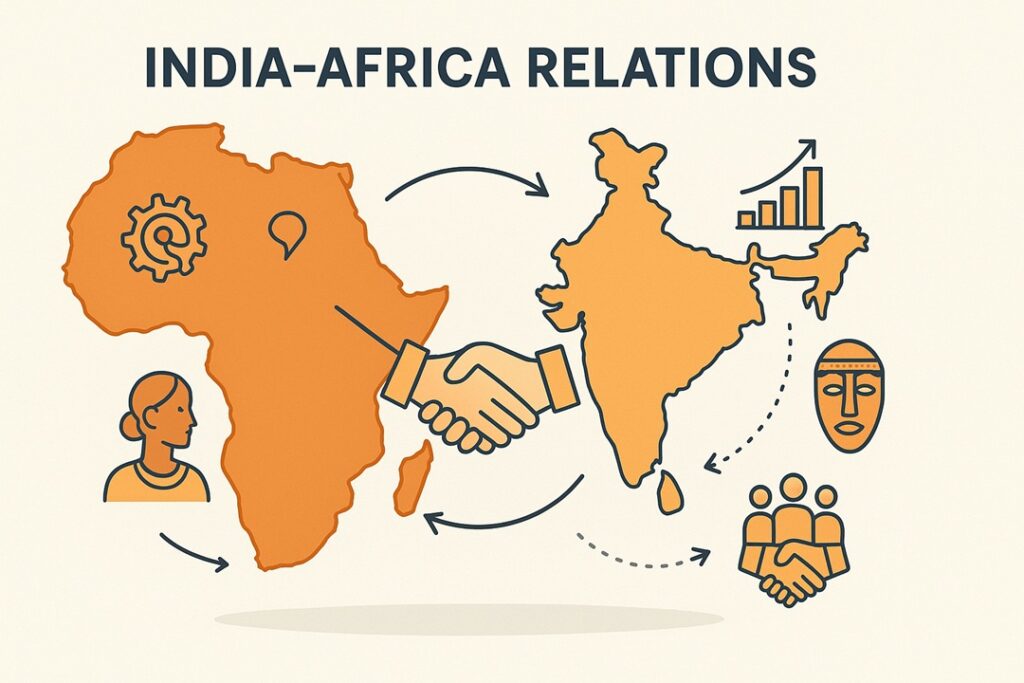India–Africa Relations: Connectivity, Capacity and Strategic Convergence

Context
India’s renewed diplomatic outreach towards Africa has sparked strategic debate, with experts stressing the need to connect, build and revive India–Africa ties ahead of the upcoming India–Africa Forum Summit (IAFS-IV).
Civilisational Links: Centuries-old Indian Ocean trade in gold, spices and textiles created deep sociocultural connections, reinforced by merchant communities and shared colonial experiences.
Political Solidarity: India supported African liberation movements through NAM, backed anti-apartheid campaigns and contributed to decolonisation diplomacy at the UN during the Cold War.
Post-1990s Engagement: Economic reforms shifted India’s Africa policy towards investment, ITEC-driven capacity building and collaboration on WTO issues, climate negotiations and UN Security Council reforms.
Contemporary Phase: IAFS-III in 2015 united all 54 African states, India opened 17 new embassies, expanded digital partnerships and supported the African Union’s permanent G20 membership in 2023.
Growing Economic Ties: India–Africa trade has crossed 100 billion dollars, placing India as Africa’s third-largest trading partner, although below China’s expansive economic footprint.
Indian Investments: India’s cumulative 75 billion dollars FDI spans telecom, hydrocarbons, pharmaceuticals, infrastructure and digital services aligned with African growth priorities.
Duty-Free Access: The DFTP scheme offers 98.2 percent tariff-free access to 38 African LDCs, boosting exports of minerals, agro-products and textiles.
Development Partnership: India’s 10 billion dollars lines of credit support 189 projects across 42 African countries in power, water supply, irrigation, transport and rural electrification.
Digital Outreach: The e-VBAB platform provides tele-education and tele-medicine services across Africa, addressing learning and healthcare gaps in remote regions.
Capacity Building: More than 40,000 Africans trained under ITEC, ICCR and the Pan-African e-Network today serve as policymakers, administrators and entrepreneurs, creating a strong human bridge.
Higher Education Collaboration: IIT-M Zanzibar, launched in 2023, represents India’s first overseas IIT campus offering advanced programmes in data science and artificial intelligence.
Maritime Cooperation: The AI-KEYME naval exercise in 2025 with nine African navies improves interoperability in anti-piracy operations, humanitarian assistance and Western Indian Ocean security.
Peacekeeping Role: India remains a major contributor to UN peacekeeping missions in Africa, especially in South Sudan, Sudan and Congo, reinforcing its credibility as a security partner.
Digital Public Infrastructure: African nations are exploring India’s UPI, Aadhaar-like identity systems and DPI solutions for modernising payments and governance mechanisms.
Energy and Climate Partnership: Collaboration includes solar cooperation under the International Solar Alliance, green hydrogen initiatives, EV ecosystems and blue economy projects.
Chinese Dominance: China’s large-scale trade and infrastructure investments continue to overshadow India’s relatively smaller economic presence in Africa.
Slow Project Execution: LoC-funded projects often face delays due to complex tendering rules, bureaucratic hurdles and limited institutional capacity in partner countries.
Loss of Diplomatic Momentum: The absence of an IAFS since 2015 has weakened institutional continuity, especially as African nations increasingly engage with partners offering quicker financing.
Financial Constraints: Indian private firms often lack the deep financial capacity to compete with China’s state-backed infrastructure model.
Political Instability: Conflicts in Sudan, the Sahel and the Horn of Africa pose risks to Indian investments, supply chains and the safety of the Indian diaspora.
Connectivity Gaps: Limited shipping lines, air routes and digital corridors raise logistical costs and hinder deeper trade and data integration.
Revival of IAFS-IV: Institutionalising IAFS, establishing a permanent Secretariat and renewing political engagement are essential for a long-term partnership.
Digital Corridor Proposal: Creating India–Africa digital corridors through UPI–Afripay linkages, DigiLocker-style identity platforms and tele-health networks can strengthen connectivity across the Global South.
Co-investment Strategy: Joint ventures in green hydrogen, EV battery minerals and digital startups with partners in Namibia, Morocco, DRC, Zambia, Kenya and Nigeria can expand strategic cooperation.
Faster LoC Delivery: A single-window LoC monitoring dashboard, strict timelines and empowered local project units are necessary to accelerate implementation.
Maritime Security Focus: Institutionalising AI-KEYME annually and enhancing cooperation with Kenya, Mauritius and Tanzania can strengthen Western Indian Ocean security architecture.
People-to-People Connect: Expanding ITEC and ICCR scholarships, supporting African students in India and deepening institutional links through IIT-M Zanzibar can enhance societal ties.
Conclusion
India–Africa relations are at a strategic turning point shaped by shared development priorities, demographic strengths and evolving global power shifts. Strengthening institutional mechanisms, improving project delivery and building co-created growth frameworks will be essential for deepening this partnership. A revitalised India–Africa engagement model can significantly contribute to the rise of the Global South in the twenty-first century.
Source : The Hindu
